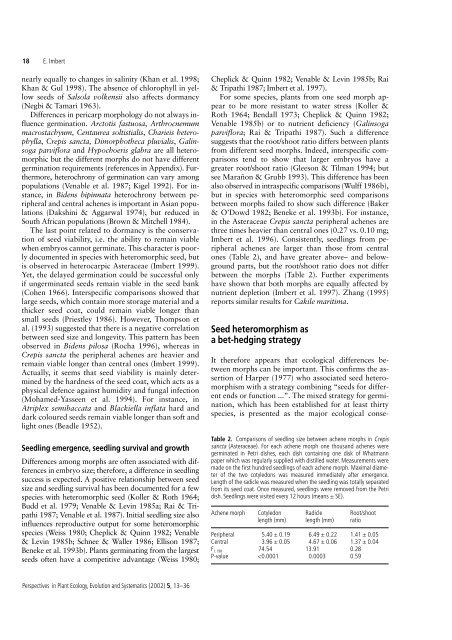Ecological consequences and ontogeny of seed ... - Accueil du site
Ecological consequences and ontogeny of seed ... - Accueil du site
Ecological consequences and ontogeny of seed ... - Accueil du site
You also want an ePaper? Increase the reach of your titles
YUMPU automatically turns print PDFs into web optimized ePapers that Google loves.
18 E. Imbert<br />
nearly equally to changes in salinity (Khan et al. 1998;<br />
Khan & Gul 1998). The absence <strong>of</strong> chlorophyll in yellow<br />
<strong>seed</strong>s <strong>of</strong> Salsola volkensii also affects dormancy<br />
(Negbi & Tamari 1963).<br />
Differences in pericarp morphology do not always influence<br />
germination. Arctotis fastuosa, Arthrocnemum<br />
macrostachyum, Centaurea soltistialis, Charieis heterophylla,<br />
Crepis sancta, Dimorphotheca pluvialis, Galinsoga<br />
parviflora <strong>and</strong> Hypochoeris glabra are all heteromorphic<br />
but the different morphs do not have different<br />
germination requirements (references in Appendix). Furthermore,<br />
heterochrony <strong>of</strong> germination can vary among<br />
populations (Venable et al. 1987; Kigel 1992). For instance,<br />
in Bidens bipinnata heterochrony between peripheral<br />
<strong>and</strong> central achenes is important in Asian populations<br />
(Dakshini & Aggarwal 1974), but re<strong>du</strong>ced in<br />
South African populations (Brown & Mitchell 1984).<br />
The last point related to dormancy is the conservation<br />
<strong>of</strong> <strong>seed</strong> viability, i.e. the ability to remain viable<br />
when embryos cannot germinate. This character is poorly<br />
documented in species with heteromorphic <strong>seed</strong>, but<br />
is observed in heterocarpic Asteraceae (Imbert 1999).<br />
Yet, the delayed germination could be successful only<br />
if ungerminated <strong>seed</strong>s remain viable in the <strong>seed</strong> bank<br />
(Cohen 1966). Interspecific comparisons showed that<br />
large <strong>seed</strong>s, which contain more storage material <strong>and</strong> a<br />
thicker <strong>seed</strong> coat, could remain viable longer than<br />
small <strong>seed</strong>s (Priestley 1986). However, Thompson et<br />
al. (1993) suggested that there is a negative correlation<br />
between <strong>seed</strong> size <strong>and</strong> longevity. This pattern has been<br />
observed in Bidens pilosa (Rocha 1996), whereas in<br />
Crepis sancta the peripheral achenes are heavier <strong>and</strong><br />
remain viable longer than central ones (Imbert 1999).<br />
Actually, it seems that <strong>seed</strong> viability is mainly determined<br />
by the hardness <strong>of</strong> the <strong>seed</strong> coat, which acts as a<br />
physical defence against humidity <strong>and</strong> fungal infection<br />
(Mohamed-Yasseen et al. 1994). For instance, in<br />
Atriplex semibaccata <strong>and</strong> Blackiella inflata hard <strong>and</strong><br />
dark coloured <strong>seed</strong>s remain viable longer than s<strong>of</strong>t <strong>and</strong><br />
light ones (Beadle 1952).<br />
Seedling emergence, <strong>seed</strong>ling survival <strong>and</strong> growth<br />
Differences among morphs are <strong>of</strong>ten associated with differences<br />
in embryo size; therefore, a difference in <strong>seed</strong>ling<br />
success is expected. A positive relationship between <strong>seed</strong><br />
size <strong>and</strong> <strong>seed</strong>ling survival has been documented for a few<br />
species with heteromorphic <strong>seed</strong> (Koller & Roth 1964;<br />
Budd et al. 1979; Venable & Levin 1985a; Rai & Tripathi<br />
1987; Venable et al. 1987). Initial <strong>seed</strong>ling size also<br />
influences repro<strong>du</strong>ctive output for some heteromorphic<br />
species (Weiss 1980; Cheplick & Quinn 1982; Venable<br />
& Levin 1985b; Schnee & Waller 1986; Ellison 1987;<br />
Beneke et al. 1993b). Plants germinating from the largest<br />
<strong>seed</strong>s <strong>of</strong>ten have a competitive advantage (Weiss 1980;<br />
Perspectives in Plant Ecology, Evolution <strong>and</strong> Systematics (2002) 5, 13–36<br />
Cheplick & Quinn 1982; Venable & Levin 1985b; Rai<br />
& Tripathi 1987; Imbert et al. 1997).<br />
For some species, plants from one <strong>seed</strong> morph appear<br />
to be more resistant to water stress (Koller &<br />
Roth 1964; Bendall 1973; Cheplick & Quinn 1982;<br />
Venable 1985b) or to nutrient deficiency (Galinsoga<br />
parviflora; Rai & Tripathi 1987). Such a difference<br />
suggests that the root/shoot ratio differs between plants<br />
from different <strong>seed</strong> morphs. Indeed, interspecific comparisons<br />
tend to show that larger embryos have a<br />
greater root/shoot ratio (Gleeson & Tilman 1994; but<br />
see Marañon & Grubb 1993). This difference has been<br />
also observed in intraspecific comparisons (Wulff 1986b),<br />
but in species with heteromorphic <strong>seed</strong> comparisons<br />
between morphs failed to show such difference (Baker<br />
& O’Dowd 1982; Beneke et al. 1993b). For instance,<br />
in the Asteraceae Crepis sancta peripheral achenes are<br />
three times heavier than central ones (0.27 vs. 0.10 mg;<br />
Imbert et al. 1996). Consistently, <strong>seed</strong>lings from peripheral<br />
achenes are larger than those from central<br />
ones (Table 2), <strong>and</strong> have greater above– <strong>and</strong> belowground<br />
parts, but the root/shoot ratio does not differ<br />
between the morphs (Table 2). Further experiments<br />
have shown that both morphs are equally affected by<br />
nutrient depletion (Imbert et al. 1997). Zhang (1995)<br />
reports similar results for Cakile maritima.<br />
Seed heteromorphism as<br />
a bet-hedging strategy<br />
It therefore appears that ecological differences between<br />
morphs can be important. This confirms the assertion<br />
<strong>of</strong> Harper (1977) who associated <strong>seed</strong> heteromorphism<br />
with a strategy combining “<strong>seed</strong>s for different<br />
ends or function ...”. The mixed strategy for germination,<br />
which has been established for at least thirty<br />
species, is presented as the major ecological conse-<br />
Table 2. Comparisons <strong>of</strong> <strong>seed</strong>ling size between achene morphs in Crepis<br />
sancta (Asteraceae). For each achene morph one thous<strong>and</strong> achenes were<br />
germinated in Petri dishes, each dish containing one disk <strong>of</strong> Whatmann<br />
paper which was regularly supplied with distilled water. Measurements were<br />
made on the first hundred <strong>seed</strong>lings <strong>of</strong> each achene morph. Maximal diameter<br />
<strong>of</strong> the two cotyledons was measured immediately after emergence.<br />
Length <strong>of</strong> the radicle was measured when the <strong>seed</strong>ling was totally separated<br />
from its <strong>seed</strong> coat. Once measured, <strong>seed</strong>lings were removed from the Petri<br />
dish. Seedlings were vi<strong>site</strong>d every 12 hours (means ± SE).<br />
Achene morph Cotyledon Radicle Root/shoot<br />
length (mm) length (mm) ratio<br />
Peripheral 5.40 ± 0.19 6.49 ± 0.22 1.41 ± 0.05<br />
Central 3.96 ± 0.05 4.67 ± 0.06 1.37 ± 0.04<br />
F 1,198 74.54 13.91 0.28<br />
P-value


